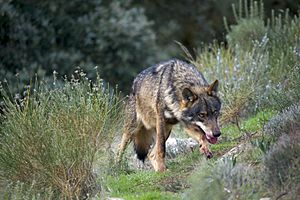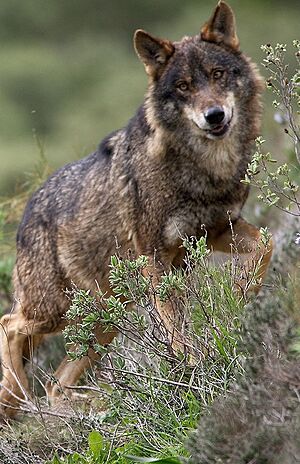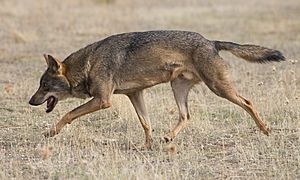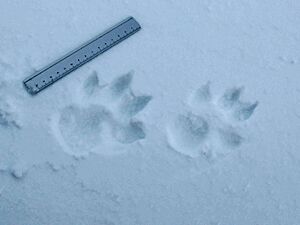Iberian wolf facts for kids
Quick facts for kids Canis lupus signatus |
|
|---|---|
 |
|
| Conservation status | |
| Scientific classification |
|
| Kingdom: | Animalia |
| Phylum: | Chordata |
| Class: | Mammalia |
| Order: | Carnivora |
| Family: | Canidae |
| Genus: | Canis |
| Species: | |
| Subspecies: |
C. l. signatus
|
| Trinomial name | |
| Canis lupus signatus Cabrera, 1907
|
|
The Iberian wolf (scientific name: Canis lupus signatus) is a special type of grey wolf. You can find it in the northwest part of the Iberian Peninsula. This area includes northwestern Spain and northern Portugal. It is home to about 2,200 to 2,700 Iberian wolves. This makes them the largest wolf population in Western Europe.
For a long time, managing the wolf population and protecting farm animals meant that hunting Iberian wolves was allowed in some areas. This changed in February 2021 when hunting them became illegal in Spain. However, because the wolf population grew a lot and caused more problems for farm animals, the Spanish Congress decided in March 2025 to allow hunting again in the region north of the Douro river. This decision helps balance the wolf population with the needs of local farmers.
Contents
Understanding the Iberian Wolf's Family Tree
The Iberian wolf is known scientifically as Canis lupus signatus. It was first described by a Spanish zoologist named Ángel Cabrera in 1907. Some scientists also consider it a type of Canis lupus lupus, which is the common grey wolf.
Scientists study the bones and DNA of wolves to understand their family connections. Studies show that the Iberian wolf has unique features in its skull and DNA compared to other European wolves. For example, a study in 2016 found that Iberian wolves and Italian wolves have very distinct genetic patterns.
Research in 2020 showed that Iberian wolves, along with wolves from Italy and the Dinaric Alps-Balkan Mountains, became separate groups about 10,500 years ago. This long time of being apart helped them develop their own special looks and genes.
What Does the Iberian Wolf Look Like?
The Iberian wolf has some special features that make it stand out. It has a lighter build than other wolves. You can often spot white marks on its upper lips and dark marks on its tail. A key feature is a pair of dark stripes on its front legs. These marks are why it's called signatus, which means "marked."
These wolves are usually about 70 to 90 centimeters (27-35 inches) tall at the shoulder. Their body length, from head to tail, is around 110 to 140 centimeters (43-55 inches). Female wolves typically weigh between 25 and 35 kilograms (55-77 pounds). Males are a bit heavier, weighing 35 to 55 kilograms (77-121 pounds).
Scientists believe these unique traits developed during the last Ice Ages. The Iberian Peninsula became isolated by large glaciers. This separation allowed the Iberian wolves to evolve differently from other wolf populations.
What Do Iberian Wolves Eat?
Iberian wolves live and hunt in small groups called packs. They are very important for the health of their ecosystem. They help keep the number of wild boars in check. This is good because too many wild boars can harm other animals, like the endangered capercaillie bird.
Their diet mainly includes wild animals such as rabbits, roe deer, red deer, and ibexes. Sometimes, they also eat smaller meat-eating animals or even fish. What they eat can change depending on where they live and what food is available.
For example, in Guadarrama National Park, most of their food (82%) comes from wild animals. Only a small part (18%) is from farm animals. Wild boars and roe deer are their favorite meals there. They might also eat smaller creatures like rodents and birds if their usual prey is scarce.
Where Do Iberian Wolves Live and How Are They Protected?

Wolf populations across Europe faced big challenges in the past. During the 18th and 19th centuries, many wolves disappeared because of human activities. By the end of the Second World War, they were gone from most of Central and Northern Europe. Their numbers kept dropping until the 1960s. Only small groups survived in places like Italy, Spain, Portugal, Greece, and Finland. Since then, wolf populations have slowly started to recover naturally.
Today, there are over 2,000 Iberian wolves living in more than 350 packs. They spread across a large area of about 140,000 square kilometers. In some areas, there are many wolves, with up to 7 wolves per 100 square kilometers. A study in 2018 found that these wolves can be divided into 11 different genetic groups. These groups live in various regions of Portugal and Spain.
In Portugal, Iberian wolves used to live in many more places until the 1930s. However, their homes were destroyed, and they lost their natural prey. This caused their territory to shrink a lot. Thankfully, their population has grown again in recent years.
People like the Spanish naturalist Félix Rodríguez de la Fuente worked hard to protect these animals. Today, hunting wolves is not allowed in Portugal. In Spain, it has been banned since 2021. However, as mentioned earlier, due to population growth and livestock issues, hunting was approved again in March 2025 for areas north of the Douro River.
In 2003, it was estimated that there were about 2,000 Iberian wolves in total. Wolves have been seen returning to new areas like Navarre, the Basque Country, and other Spanish provinces. A wolf was even found in Catalonia, where the last native wolf was seen in 1929. However, this particular wolf was an Italian wolf that had traveled from France. As of 2013, Portugal had an estimated 300 Iberian wolves.
Protecting these wolves is an ongoing effort. In October 2013, some environmental groups asked for a new count of the wolves, thinking the numbers might be too high. Other groups gathered many signatures to ask for more protection for the wolves. Even with bans, some wolves still die due to human actions, including hunting that is not allowed. Many organizations are working to ensure these majestic animals are safe.
The Wolves of Sierra Morena
In the Sierra Morena mountains, located in southern Spain, a very small group of wolves lived alone for about 50 years. This isolation made it hard for them to find new mates. The last time a pair of wolves that could have babies was seen there was in 2013. Sadly, a detailed study in 2016 could not find any breeding wolves in that area.
Scientists studied the DNA from a wolf found in 2003. They discovered that these wolves had a lot of inbreeding, meaning they were mating with close relatives. Also, about 30% of their DNA was similar to dog DNA. This suggests that as their numbers dropped, some wolves might have mated with dogs. It is now believed that the wolves in the Sierra Morena region might no longer exist. This shows how important it is for animal populations to stay connected and have enough individuals to thrive.
Images for kids






